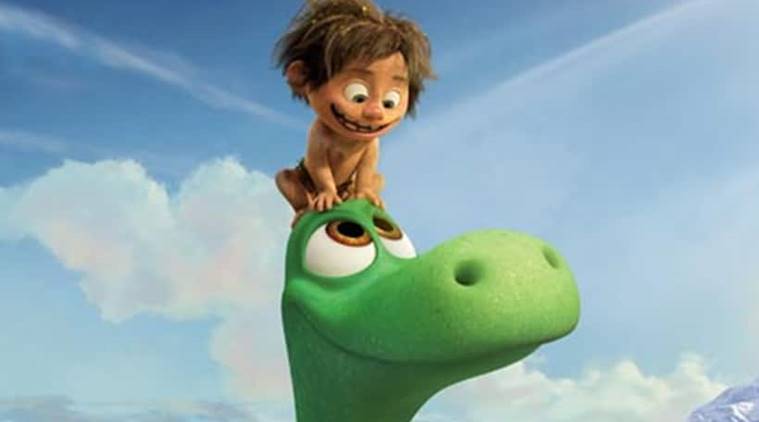A Science teacher explains: Fascinating facts about dinosaurs
The oldest known dinosaur is Eoraptor, a meat-eater that lived 228 million years ago. Most palaeontologists believe that birds are the only surviving dinosaurs. So dinosaurs aren’t really extinct because their descendants are still living.
 A still from the movie The Good Dinosaur
A still from the movie The Good Dinosaur
By Meenambika Menon
What does the word ‘dinosaur’ mean?
The word ‘dinosaur’ means ‘terrible lizard’, and comes from the Greek words dino (meaning ‘terrible’) and saur (meaning ‘lizard’). When scientists first discovered dinosaur fossils, they imagined them to be the remains of huge lizards from the past.
The word was invented by Sir Richard Owen in 1852. It also means a person or thing that is outdated or has become obsolete because of failure to adapt to changing circumstances, as dinosaurs could not survive the changes!
What was the biggest dinosaur? Which was the smallest?
The largest complete dinosaur we know of was Brachiosaurus (“arm lizard”); it reached 23m in length and 12m in height (about the length of two large school buses and the height of a four-story building!).
The smallest fully-grown fossil dinosaur is the little bird-hipped plant-eater like lesothosaurus, which was only the size of a chicken.
What were the different species of dinosaurs?
At present over 700 different species of dinosaurs have been identified and named. However, palaeontologists believe that there are many newer and different dinosaur species still to be discovered.
How and when did dinosaurs get extinct?
Dinosaurs went extinct about 65 million years ago (at the end of the Cretaceous Period), after living on Earth for about 165 million years. Plants died and food became scarce. All the dinosaurs — except for the ancestors of modern birds — and three-quarters of the creatures living on earth went extinct. To this day, scientists debate what caused this sudden change. The leading theories involve a meteor strike and a giant volcano.
Non-bird dinosaurs lived between about 245 and 66 million years ago, in a time known as the Mesozoic Era. This was many millions of years before the first modern humans, homo sapiens, appeared. Scientists divide the Mesozoic Era into three periods: the Triassic, Jurassic and Cretaceous.
Did they live all over the world?
Fossils of dinosaurs have now been found on every continent, almost everywhere that rocks of Late Triassic, Jurassic, or Cretaceous rocks are exposed on the Earth’s surface. Dinosaurs lived in the era when the present-day continents were not divided and there was one landmass called Pangea. Once this land mass got divided dinosaurs evolved on the respective lands and hence we find fossils on every present day continent.
What did they eat? Were they more plant-eaters or meat-eaters?
Some dinosaurs were carnivores (meat-eaters) but most were herbivores (plant-eaters). Only a few of the known dinosaurs were omnivores (eating both plants and animals). Some examples of omnivores are Ornithomimus and Oviraptor, which ate plants, eggs, insects, etc. Also, most herbivores are “accidental omnivores” in that when they are eating plants, they also ingest a lot of insects and small animals.
How smart were dinosaurs? (Plant-eating ones are said to have tiny brains.)
Dinosaurs were once regarded as stupid animals, but it is now realised that some of the smaller carnivores had above-average intelligence for reptiles. This newfound optimism for dinosaur intelligence has led to highly exaggerated portrayals in pop-cultural works like Jurassic Park. Paleontologists now regard dinosaurs as being very intelligent for reptiles, but generally not as smart as their avian descendants.
How fast could they run?
The fastest speeds evident from dinosaur tracks (a medium-sized theropod in this case) are about 12 metres per second (about 27 mph), a little faster than the best Olympic sprinters.
What kind of habitat did they live in?
They did not live in the same kind of habitat. Because of the splitting of supercontinent Pangea into smaller land masses dinosaurs evolved and are believed to have lived in a variety of habitats, from deserts to thick forests.
Did birds evolve from dinosaurs?
The present scientific consensus is that birds are a group of theropod dinosaurs that originated during the Mesozoic Era. A close relationship between birds and dinosaurs was first proposed in the nineteenth century after the discovery of the primitive bird Archaeopteryx in Germany.
What other animals lived in the age of the dinosaurs? Are they still around today?
Crocodiles, snakes, bees, sharks, horseshoe crabs, seastars, lobsters, duck-billed platypuses, green sea turtles, tuatara and cockroaches are some of the main animals who lived along with dinosaurs and are still around.
What are some other fascinating facts about dinosaurs?
- The oldest known dinosaur is Eoraptor, a meat-eater that lived 228 million years ago.
- Most dinosaurs hatched from eggs, and they could not fly or live in water.
- Dinosaurs are classified as reptiles. They are divided into two groups based on the structure of the hip. One group has lizard-like hips and the other group has bird-like hips.
- Most palaeontologists, scientists that study dinosaurs, believe that birds are the only surviving dinosaurs. So dinosaurs aren’t really extinct because their descendants are still living.
- Some dinosaurs were carnivores, meat-eaters, and some were herbivores, plant-eaters. Some walked on two legs, while others walked on all four legs. Some had horns and spikes, others had thick bumpy skin, and some even had feathers.
- The colour of all dinosaurs is unknown because no one was alive at that time in history.
(Source: Some inputs have been sourced from kidsconnect.com, worldatlas.com.)
(The writer is Lead, Curriculum-Science & Math at Shiv Nadar School.)
Photos





- 01
- 02
- 03
- 04
- 05


























